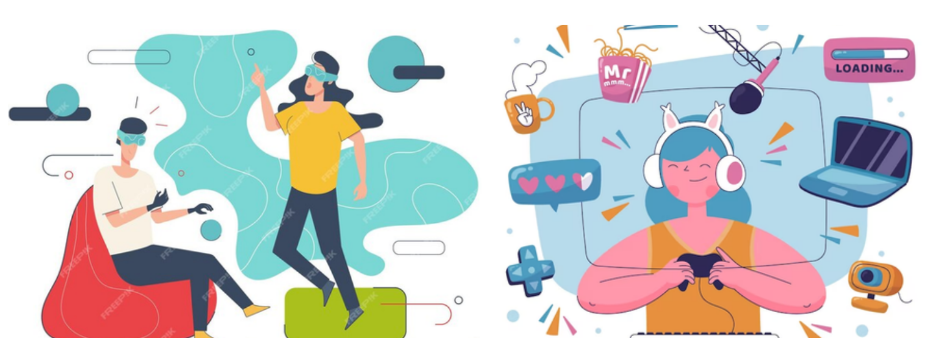The World Health Organization (WHO) has predicted that depression will lead the global disease burden by 2030, With the existing services available in under-developed and developing countries to meet the enormous mental health needs, gamification for mental health seems promising.
Gamification, the application of game design elements in on-game contexts is often said to be based on the principles of Self Determination Theory (SDT)6, the SDT states that psychological growth and well-being are generated through the gratification of three innate psychological needs: autonomy, competence, and relatedness.
Autonomy: SDT posits that individuals have a fundamental need to feel autonomous, or in control of their own actions and choices. For example, the gamified mobile application “Breeze,” is used for mindfulness meditation and relaxation. This app deducts biosignals (e.g., inhalations, exhalations, pauses) and provides users with real-time visual guidance and feedback on their performance. This feature of the app helps the users to adjust their learning pace.
Competence: SDT suggests that individuals are motivated to master tasks and develop competencies. For example, “reward bank” is a key feature of the gamified intervention “SmartCAT,” which targets anxiety management in children. Once young users have mastered an emotion regulation skill, a motivational message appears, and the reward bank shows the number of points gained in that round and the number of additional.
Relatedness: SDT highlights the importance of social connections and relationships in motivating behavior. Gamification can foster relatedness by incorporating social elements such as collaboration, competition, and peer support. For example, in “ONYA—The Wellbeing Game” seeks to increase social affiliation and wellness through team events for users.
Among the other digital interventions, gamifications offers four key areas of potential. First, attractiveness. Games are among the most popular forms of entertainment globally, reaching hugely diverse audience. The average age of gamer is over 30 years old and 45% are female. Second, gamifications are more appealing to some users than traditional model and it also reduces barriers
to therapy such as stigma and help negation. Third, gamifications offers a platform for continuous engagement through the use of reward, fun and other futures. Four, gamification facilitates the visualization of complex ideas, such as negative thoughts, and allowing manipulation of such images. For example, virtual reality games are being used to treat phobia and anxiety disorders.
Recently, a meta analytic review (statistical method used in research to synthesize and summarize findings from multiple studies on a specific topic or research question), was carried out by researchers investigating the effectiveness of gamified interventions in support of mental health. The researchers analysed 42 studies covering 5792 participants across eight world regions. Based on the study, the following suggestions were made:
- Gamification is less effective in mitigating depressive symptoms in clinical samples (people who were currently having or had recovered from psychiatric or physical health problems, including depression, breast cancer) than in non-clinical samples.
- Gamified interventions may function better as a supplement to rather than a replacement of traditional treatments for clinical sample.
The above evidences provide scalable platform for scholars and practitioners to collaborate with game developers in co-designing more innovative, effective gamified interventions that can bring in desirable impacts on overall community mental health.
References
- Deci, E. L., & Ryan, R. M. (Eds.). (2004). Handbook of self-determination research. University
Rochester Press. - Fleming T, Sutcliffe K, Lucassen M et al. Serious games and gamification in clinical psychology.
Reference module in neuroscience and biobehavioral psychology. Amsterdam: Elsevier, 2020. - Lindner, P., Miloff, A., Bergman, C., Andersson, G., Hamilton, W., & Carlbring,
P. (2020). Gamified, automated virtual reality exposure therapy for fear of spiders: a single-subject trial
under simulated real-world conditions. Frontiers in psychiatry, 11, 116. - Pramana, G., Parmanto, B., Kendall, P. C., & Silk, J. S. (2014). The SmartCAT: an m-health platform
for ecological momentary intervention in child anxiety treatment. Telemedicine and e-Health, 20(5), 419-
427. - Shih, C. H., Tomita, N., Lukic, Y. X., Reguera, Á. H., Fleisch, E., & Kowatsch, T. (2019). Breeze:
Smartphone-based acoustic real-time detection of breathing phases for a gamified biofeedback breathing
training. Proceedings of the ACM on interactive, mobile, wearable and ubiquitous technologies, 3(4), 1-
30. - Six, S. G., Byrne, K. A., Tibbett, T. P., & Pericot-Valverde, I. (2021). Examining the effectiveness of
gamification in mental health apps for depression: systematic review and meta-analysis. JMIR mental
health, 8(11), e32199. - Tolks, D., Sailer, M., Dadaczynski, K., Lampert, C., Huberty, J., Paulus, P., & Horstmann, D. (2019).
ONYA—The wellbeing game: How to use gamification to promote wellbeing. Information, 10(2), 58. - World Health Organization (2015). Global burden of mental disorders and the need for a
comprehensive, coordinated response from health and social sectors at the country level: Report by the
secretariat.2015-07- 22.
http://apps.who.int/gb/ebwha/pdf_files/EB130/B130_9-en.pdf.
About the author


